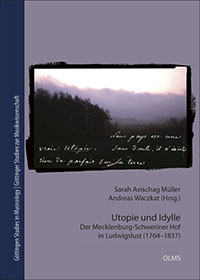
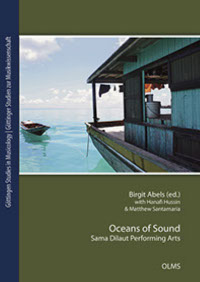
Göttingen Studies in Musicology
ed. by Birgit Abels, M. J. Grant (vol. 1–4) and Andreas Waczkat, Hildesheim etc.: Olms
Click on the title for details, click on the book cover to get to olms.de
Vol. 1: Utopie und Idylle. Der Mecklenburg-Schweriner Hof in Ludwigslust 1764–1837, hrsg. von Sarah Avischag Müller und Andreas Waczkat (in Vorbereitung).

Vol. 2: Composers in the Gulag under Stalin, ed. by Inna Klause, Andreas Waczkat and Stefan Weiss (in Vorbereitung).

Vol. 3: Oceans of Sound. Sama Dilaut Performing Arts, ed. by Birgit Abels with Hanafi Hussin and Matthew Santamaria, 2012.
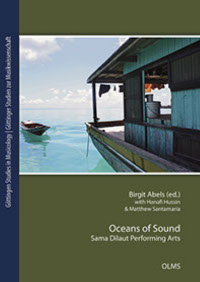
The Austronesian-speaking Sama peoples make up one of the most widespread cultural groups within the Southeast Asian island world. The so-called sea-nomadic Sama Dilaut, part of the linguistic sub-group of the Sama-Bajau, form a very distinct community both socially and culturally. The performing arts are a crucial part of their life and cultural identity. Yet, previous studies of Sama Dilaut societies have hardly touched upon their music or dance forms. This edited volume attempts to close this gap in our knowledge. Contributions focus on kulintangan and other types of instrumental music, song repertoire and dance. Other topics include:
- Continuity and transformation in Sama Dilaut performing arts
- Issues of globalisation and identity negotiation through music
- Transnational ows and their impact on Sama Dilaut music and dance
- The relationship between Sama Dilaut performing arts and those of surrounding communities
- The impact of constructions of nationhood on Sama Dilaut music-making
Die austronesisch-sprachigen Sama stellen eine der am weitesten verbreiteten Gruppen in der südostasiatischen Inselwelt dar. Innerhalb der Sama bilden die Sama Dilaut, die der linguistischen Untergruppe der Sama-Bajau angehören, eine sowohl in sozialer als auch kultureller Hinsicht besondere Gemeinschaft. Die darstellenden Künste sind entscheidender Bestandteil ihres Lebens und ihrer kulturellen Identität. Bisherige Studien über die Sama Dilaut haben sich jedoch noch kaum mit ihrer Musik und ihrem Tanz beschäftigt. Ziel dieses Sammelbands ist es, diese Wissenslücke zu schließen. Seine Beiträge sind der Kulintangan-Musik und anderen Formen von Instrumentalmusik, Liederrepertoire und Tanz gewidmet. Weitere Themen sind:
- Kontinuität und Transformation in den darstellenden Künsten der Sama Dilaut
- die musikalische Verhandlung von Globalisierung und Identitätsverhandlung
- transnationale Strömungen und ihr Einfluss auf Musik und Tanz der Sama Dilaut
- die Beziehung zwischen den darstellenden Künsten der Sama Dilaut und denen benachbarter Gemeinschaften
- der Einfluss von Konstruktionen nationaler Identität auf das Musizieren der Sama Dilaut
Vol. 4: The Soundtrack of Conflict: The Role of Music in Radio Broadcasting in Wartime and in Conflict Situations, ed. by M. J. Grant and Férdia Stone-Davis, 2013.
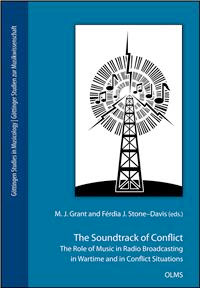
Since the early twentieth century, radio has been one of the most important media both generally and in the specific context of armed conflict. Relatively cheap and with the ability to transmit over long ranges-and over international borders-radio has become central to the wartime strategies of governments and guerrilla groups alike. The role of music on radio in wartime and in conflict situations has, however, only rarely been the focus of scholarly attention, despite the central role that music plays in this medium.
The essays in this volume offer case studies spanning over eighty years and five continents. They explore the many important roles that music broadcast on radio can play in wartime and in conflict situations-as a means of information (and misinformation), as a communication medium by those separated by and yet connected through the fighting, and as an aid to managing the complex emotions that are experienced. Moreover, the essays demonstrate that music is not just a soundtrack to conflict, but can also influence the very course that a conflict takes. In the range of examples discussed and the theoretical issues raised, the volume presents a significant contribution to the musicological study of war and conflict.
Seit dem frühen 20. Jahrhundert hat sich das Radio zu einem der wichtigsten Medien entwickelt - und das gilt nicht nur allgemein für die Gesellschaft, sondern auch und gerade für bewaffnete Konflikte. The Soundtrack of Conflict beschäftigt sich mit den vielen wichtigen Rollen, die Musik in diesem Medium und in diesem Kontext spielen kann. Die Beiträge des Buches demonstrieren, dass solche Musik nicht bloß ein Soundtrack zum Konfliktgeschehen ist, sondern dass sie die Dynamik von Konflikten maßgeblich mitbestimmen kann. Mit Fallstudien, die einen Zeitraum von über achtzig Jahren sowie ein geografisches Spektrum von fünf Kontinenten umfassen, leistet der Band deshalb einen wesentlichen Beitrag zur musikwissenschaftlichen Erforschung von Krieg und Konflikt.
Vol. 5: Christine Hoppe: Der Schatten Paganinis. Virtuosität in den Kompositionen Heinrich Wilhelm Ernsts. Mit einem Werkverzeichnis, 2014.

Heinrich Wilhelm Ernst (1814–1865) war Violinvirtuose. Er war aber auch Komponist. Diskurse über Virtuosen und Virtuosität werden bisher jedoch vor allem vermittels einer Zugangsweise über die Präsentations- und Rezeptionsebene beschrieben. Und so werden auch die Kompositionen Ernsts bisher über diese als genuin virtuos erscheinende Beschreibungskategorie sortiert – ein undifferenzierter Virtuositätsbegriff steht einer angemessenen Auseinandersetzung mit den Werken ursächlich im Weg.
Betrachtet man jedoch das Phänomen Virtuosität als ein innermusikalisches, eröffnet sich die Chance, eines bisher vernachlässigten Aspekts des Assoziationsspektrums Virtuosität über die gezielte Spezifizierung am Beispiel der Werke dieses Komponisten habhaft zu werden: Durch die analytische Betrachtung virtuoser Mittel und ihrer Funktionszuweisung innerhalb der Kompositionen gelingt eine produktive Weiterentwicklung des Begriffsfelds, die es ermöglicht, Heinrich Wilhelm Ernst aus dem Schatten der vielfältigen, vor allem außermusikalischen Virtuositäts-Diskurse um Paganini herauszulösen.
Im Anhang liefert ein kommentiertes Werkverzeichnis ausführliche Informationen zu jeder nachgewiesenen Komposition Ernsts.
Ausgezeichnet mit dem Preis des Stiftungsrats der Georg-August-Universität Göttingen Stiftung Öffentlichen Rechts in der Kategorie »Herausragende Nachwuchspublikation«.
Vol. 6: Embracing Restlessness. Cultural Musicology, ed. by Birgit Abels, 2016.

The term "cultural musicology" has been around for more than half a century, and it has harbored a number of musicological visions which share one fundamental goal: broadly speaking, aspiring to better understand music and remaining eager to find ever-new ways to do so. Recent cultural musicology seeks to understand musical activities as cultural practices in a manner that aims to reach beyond the systematic analysis of verbal and musical - musicked - discourse and of the conditions in which it is enacted. Its primary interest is in exploring our primarily intellectual possibilities to comprise of musicking as epistemologies through which humans musically relate to, and make sense of, their surrounding world in a physical, social, and discursive sense.
From this, a few key areas of inquiry emerge, and this edited volume presents a first-of-its-kind exploration of current critical thinking and research in and about cultural musicology. In exploring specific musical practices, the contributors discuss the (hi)stories, theoretical framework, and central concepts of current cultural musicology. In-between the lines, it becomes clear that cultural musicology is about looking for questions and perspectives rather than answers and presumed facts, about refusing to be content with anything that may be found along the way, and about remaining eager to discover new approaches and ways to think about music: about intellectual restlessness, and embracing it.
This edited volume includes contributions from Birgit Abels, Charissa Granger, Lawrence Kramer, John Richardson, and Eva-Maria van Straaten.
Vol. 7: Music Moves. Musical Dynamics of Relation, Knowledge and Transformation, ed. by Charissa Granger, Friedlind Riedel, Eva-Maria van Straaten and Gerlinde Feller, 2016.
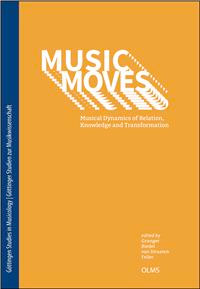
Music Moves. While the main title of this edited volume suggests a rather unambiguous stand towards the manifold possible relations between music and movement, the various papers included each nuance this seemingly univocal articulation. Rather than providing the reader with an all-inclusive theory on movement that is simply mapped onto the various complex musical dynamics this volume attends to, each chapter explores these dynamics in and on their own terms. Besides a focus on questions of music and movement, the chapters collected in this volume have common conceptual, methodological and theoretical ground. Issues that have been of central concern for musicology (here understood in its most inclusive sense), as, for example, questions of power, musical meaning and identity construction, underlie most of the chapters included here. Three uniting themes that have been of crucial importance both within the broad field of musicology as well as cultural studies, however, emerge most prominently from the individual papers: relation, knowledge and transformation. These themes have been used by the editors to both frame the individual contributions, and to relate these to each other as well as to the volume’s main theme. Due to its broad geographical, musical and theoretical range, the approximations of music and movement offered within this volume explore questions of relevance not only to the broad field of musicology, but also to current debates within anthropology, critical theory, philosophy, post-colonial theory and cultural studies.
Vol. 8: Timo Evers: »…to rescue the Science of Music from the mysterious Darkness in which it was wrapped.« August Friedrich Christoph Kollmann und seine Schriften: Biographie, Theorie und Expertise im Kontext musikalischer Wissensvermittlung um 1800.

August Friedrich Christoph Kollmann (1756–1829) und seine Schriften waren bei den Zeitgenossen stark umstritten: Kein geringerer als Charles Burney apostrophierte Kollmanns Kompositionslehre als eine hervorragende Arbeit von außergewöhnlicher Qualität, wogegen sie von M. P. King als verwirrendes »Spinnennetz-System« bezeichnet wurde. Der sich über rund 30 Jahre bis zu Kollmanns Tod erstreckende Streit hatte mehrere Ursachen. Die wohl entscheidende ist sicher die Wahl des Begriffs einer Wissenschaft der Musik: Auf Basis einer empirischen Methode sowie eines von J. P. Kirnberger geprägten erweiterten Harmoniesystems sollten Kollmanns Schriften der Musik und ihrem sich zum Expertenvermittler aufgewerteten Autor nichts weniger als den höchsten Rang innerhalb einer im Entstehen begriffenen Wissenschaft von der Musik sichern. Diesem Spannungsfeld nähert sich die Studie auf Basis bisher unbekannter bzw. hier erstmals edierter Quellen: In vier aufeinander bezogenen Teilen werden zunächst zeitgenössische bzw. aktuelle Konzepte zur Musik als Wissenschaft sowie zu Kulturtransfer und musikalischer Wissensvermittlung diskutiert. Untersuchungen zu Kollmanns Biographie, Theorie und Expertise runden die Studie ab.
Vol. 9: Mbira Music | Musics. Structures and Processes, ed. by Klaus-Peter Brenner (in Vorbereitung).

Vol. 10: Exploring Virtuosities. Heinrich Wilhelm Ernst, Nineteenth-Century Musical Practices and Beyond, ed. by Christine Hoppe, Melanie von Goldbeck and Maiko Kawabata.
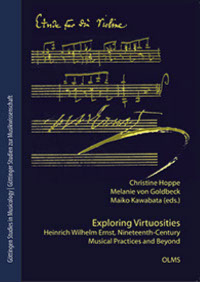
Over the last decade, musicological interest in both the composing virtuoso of the nineteenth century and the phenomenon of virtuosity has increased. Moving beyond approaches to music solely in terms of works allowed for a range of perspectives on concepts of virtuosity to emerge. Such cultural theory-based approaches crucially put the traditional musicological image of the virtuoso into a broader context. Recent advances in performance studies, furthermore, emphasise the need to include factors such as staging, the audience, sound and space, and musical practices, in our understanding of the complex phenomenon of virtuosity. The present volume tries to meet the challenges raised by these multi-layered perspectives by varying the foci on virtuosity – from specific attention to individual virtuosi and considerations of virtuosity’s historical and social context to broader questions regarding innovations in the current landscape and future virtuoso phenomena. The broad range of topics centres on the composer and virtuoso Heinrich Wilhelm Ernst and his immediate sphere of influence. The contributions in the present volume not only reveal the complexity of the research field of virtuosity but also liberate Heinrich Wilhelm Ernst from the shadow of fixed, mainly non-musical, discourses on virtuosity around Paganini.
The enclosed CD with recordings by Guillaume Tardif, Philippe Borer, Clive Brown and Friederike Spangenberg enriches these texts by including the dimension of sound.
Im Laufe des letzten Jahrzehnts hat das musikwissenschaftliche Interesse sowohl an dem komponierenden Virtuosen des 19. Jahrhunderts als auch am Phänomen Virtuosität deutlich zugenommen. Durch die Weitung des (musik-)wissenschaftlichen Blicks durch kulturtheoretische Ansätze setzt das traditionelle musikwissenschaftliche Bild des Virtuosen in einen breiteren Kontext und es entstehen Konzepte von Virtuosität, die weit über das musikalische Werk hinausgehen. Jüngste Entwicklungen auf dem Gebiet der Performance-Studies unterstreichen darüber hinaus die Notwendigkeit, Faktoren wie Inszenierung, Publikum, Klang und Raum und musikalische Praktiken in unser Verständnis des komplexen Phänomens Virtuosität einzubeziehen. Diese vielschichtigen Perspektiven werden im vorliegenden Band ausbalanciert, indem der Fokus auf den Gegenstand sich verändert – von der eng gefassten Aufmerksamkeit auf einzelne Virtuosen und der Analyse des historischen und sozialen Kontextes von Virtuosität bis hin zu umfassenderen Fragen nach dem Hervorbringen von Neuerungen für die gegenwärtige wissenschaftliche und künstlerischen Landschaft oder zukünftiger virtuoser Phänomene. Das breite Themenspektrum konzentriert sich dabei auf den Komponisten und Virtuosen Heinrich Wilhelm Ernst und seinen unmittelbaren Einflussbereich. So zeigen die Beiträge im vorliegenden Band nicht nur die Komplexität des Forschungsfeldes Virtuosität, sondern befreien Ernst auch aus dem Schatten der festen, vorwiegend nicht-musikalischen Diskurse über Virtuosität um Paganini.
Die beiliegende CD mit Aufnahmen von Guillaume Tardif, Philippe Borer, Clive Brown und Friederike Spangenberg bereichert diese Texte, indem sie die Dimension Klang mit ein- und erschließt.
Vol. 11: Karen Thöle: »…mutavimus cantum cum omni melodia.« Die Choralreform der Bursfelder Kongregation (in Vorbereitung).
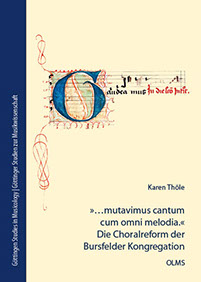
Impressum
Prof. Dr. Dr. h.c. Andreas Waczkat | Georg-August-Universität Göttingen |
Kurze Geismarstr. 1 | D–37073 Göttingen
Telefon: +49 551 39-25072 | mail: andreas.waczkat@phil.uni-goettingen.de
Internet: www.gwdg.de/~awaczka
Inhaltlich Verantwortlicher gemäß § 55 Abs. 2 RStV: Andreas Waczkat (Anschrift wie nebenstehend)
Haftungshinweis: Trotz sorgfältiger inhaltlicher Kontrolle übernehme ich keine Haftung für die Inhalte externer Links. Für den Inhalt der verlinkten Seiten sind ausschließlich deren Betreiber verantwortlich.